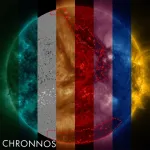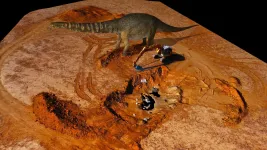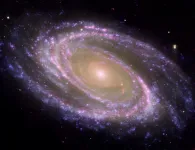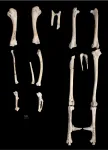Holes in the solar atmosphere: Artificial intelligence spots coronal holes to automate space weather
2021-06-07
(Press-News.org) Scientists from the University of Graz (Austria), Skoltech and their colleagues from the US and Germany have developed a new neural network that can reliably detect coronal holes from space-based observations. This application paves the way for more reliable space weather predictions and provides valuable information for the study of the solar activity cycle. The paper was published in the journal Astronomy & Astrophysics.
Much like our life on Earth depends on the light of the Sun, our electronic "life" depends on the activity of our closest star and its interactions with Earth's magnetic field. For the human eye, the Sun appears almost constant, but the Sun is very active, frequently showing eruptions and causing geomagnetic storms on Earth. For this reason, the outer solar atmosphere, the solar corona, is constantly being monitored by satellite-based telescopes.
In these observations, one of the prominent features are extended dark regions called coronal holes. They appear dark because plasma particles can escape along the magnetic field from the solar surface into interplanetary space, leaving a 'hole' in the corona. The escaping particles form high-speed solar wind streams that can eventually hit Earth, causing geomagnetic storms. The appearance and location of these holes on the Sun varies in dependence of the solar activity, giving us also important information on the long-term evolution of the Sun.
"The detection of coronal holes is a difficult task for conventional algorithms and is also challenging for human observers, because there are also other dark regions in the solar atmosphere, like filaments, that can be easily confused with a coronal hole," says Robert Jarolim, a research scientist at the University of Graz and the lead author of the study.
In their paper, the authors describe a convolutional neural network called CHRONNOS (Coronal Hole RecOgnition Neural Network Over multi-Spectral-data) that they developed to detect coronal holes. "Artificial intelligence allows us to identify coronal holes based on their intensity, shape, and magnetic field properties, which are the same criteria as a human observer takes into account," Jarolim says.
"The solar atmosphere appears very different when observed at different wavelengths. We used images recorded at different extreme ultraviolet (EUV) wavelengths along with magnetic field maps as input to our neural network, which enables the network to find relations in the multi-channel representation," Astrid Veronig, professor at the University of Graz and co-author of the publication, adds.
The authors trained their model with about 1700 images in the 2010-2017 time range and showed that the method is consistent for all solar activity levels. The neural network was evaluated by comparing the results to 261 manually identified coronal holes, matching human labels in 98% of the cases. In addition, the authors examined the detection of coronal holes based on magnetic field maps, that appear vastly different than EUV observations. For a human, the coronal holes cannot be identified from these images alone, but the AI learned to perceive the images differently and was able to identify coronal holes.
"This is a promising result for future ground-based coronal hole detection, where we cannot directly observe coronal holes as dark regions as in space-based extreme ultraviolet and soft X-ray observations, but where the solar magnetic field is measured on a regular basis," says Tatiana Podladchikova, assistant professor at the Skoltech Space Center and a co-author of the paper.
"And whatever storms may rage, we wish everyone a good weather in space", concluded Podladchikova.
INFORMATION:
The new method was developed with the support of Skoltech's high-performance cluster for the anticipated Solar Physics Research Integrated Network Group (SPRING) that will provide an autonomous monitoring of the Sun using cutting-edge technology of observational solar physics. SPRING is a part in the SOLARNET project launched in preparation to the European Solar Telescope (EST) initiative supported by the EU research and innovation funding program Horizon 2020. UniGraz and Skoltech represent Austria and Russia in the SOLARNET consortium of 35 international partners. Other institutions involved in this research include Columbia University (USA), Max-Planck-Institut für Sonnensystemforschung (Germany) and NorthWest Research Associates (USA).
Skoltech is a private international university located in Russia. Established in 2011 in collaboration with the Massachusetts Institute of Technology (MIT), Skoltech is cultivating a new generation of leaders in the fields of science, technology and business, is conducting research in breakthrough fields, and is promoting technological innovation with the goal of solving critical problems that face Russia and the world. Skoltech is focusing on six priority areas: data science and artificial intelligence, life sciences, advanced materials and modern design methods, energy efficiency, photonics and quantum technologies, and advanced research. Web: https://www.skoltech.ru/.
Video [https://www.youtube.com/watch?v=kqkjJC3eH0c]: Animated version of the detected coronal holes over almost 11 years. The identified coronal holes are indicated by red contour lines. The Sun changes over the solar cycle and reaches its maximum activity in 2014. Credit: from Jarolim et. al., 2021.
[Attachments] See images for this press release:

ELSE PRESS RELEASES FROM THIS DATE:
2021-06-07
Carbon loss in Canadian peatland is projected to increase by 103 per cent under a high emission scenario, according to new research led by scientists from the University of Waterloo.
The results of the study, which was published today in Nature's Communications Earth & Environment journal, reinforces the urgent need for a comprehensive understanding of peatlands as evolving sources of atmospheric CO2 in a warming world.
Peatlands, which are a type of wetland, are some of the most valuable ecosystems globally. In addition to their role in preserving biodiversity and minimizing ...
2021-06-07
Older Chinese immigrants who adjust to their new cultural environment by learning the language, following the country's media and socializing with local residents can reduce acculturation gap with their adult children and protect their cognitive function, according to a Rutgers study.
The study, published in the journal Aging and Mental Health, is one of the first to explore the relationship between intergenerational families, acculturation and cognitive function among older Chinese Americans.
Researchers looked 2,900 Chinese Americans over age 60 who had at least one child and who participated in the PINE Study, an epidemiological study of older Chinese Americans. They analyzed three areas of acculturation - language, media use and ethnic social relations - and how they corresponded ...
2021-06-07
What's as long a basketball court, taller than a b-double and has just stomped into the record books as Australia's largest dinosaur? It's time to meet Australotitan cooperensis - a new species of giant sauropod dinosaur from Eromanga, southwest Queensland.
Australotitan, "the southern titan", has been scientifically described and named by Queensland Museum and Eromanga Natural History Museum palaeontologists.
It is estimated to have reached a height of 5-6.5 metres at the hip and 25- 30 metres in length and sits within the top 10-15 largest dinosaurs world-wide, representing Australia's entry into the largest species to have ever walked the Earth.
The fossilised skeleton was originally nicknamed 'Cooper' after Cooper Creek, ...
2021-06-07
An international team of scientists led from the Centre for Astrobiology (CAB, CSIC-INTA), with participation from the Instituto de Astrofísica de Canarias (IAC), has used the Gran Telescopio Canarias (GTC) to study a representative sample of galaxies, both disc and spheroidal, in a deep sky zone in the constellation of the Great Bear to characterize the properties of the stellar populations of galactic bulges. The researchers have been able to determine the mode of formation and development of these galactic structures. The results of this study were recently published in The Astrophysical Journal.
The researchers focused their study on massive disc and spheroidal galaxies, using imaging data from ...
2021-06-07
Bad sleep causes severe health issues and affects our ability to concentrate, memorize, and cope with challenging situations. Individuals with neurodevelopmental disorders such as autism and intellectual disability, frequently suffer from sleep problems. However, little is known about their underlying mechanisms. In Science Advances, a Dutch-American research team, coordinated by Radboudumc, now describes how these problems can arise. Mimicking two genetic causes of autism in fruit flies, they uncovered that flies show the same sleep problems as the patients, and that the disturbed ...
2021-06-07
Ancient chickens lived significantly longer than their modern equivalents because they were seen as sacred - not food - archaeologists have found.
Experts have developed the first reliable method of finding the age of fowl who lived thousands of years ago. Their research shows they lived to advanced ages, and were kept for ritual sacrifice or cockfighting rather than meat or egg production.
Chickens today live for a few weeks (in the UK poultry birds live for between 33 and 81 days), but during the Iron Age, Roman and Saxon period they lived up to the age of two, three or even four years old.
Calculating ...
2021-06-07
On Friday, 11 June, Europe's men's football teams will start the European Championship a year later than planned. The favourite this time is France with a probability of winning of 14.8 per cent. This is what an international team of researchers consisting of Andreas Groll and Franziska Popp (both TU Dortmund, Germany), Gunther Schauberger (TU Munich, Germany), Christophe Ley and Hans Van Eetvelde (both Ghent University, Belgium), Achim Zeileis (University of Innsbruck, Austria) and Lars Hvattum (Molde University College, Norway) has shown with the help of machine learning. Their forecast combines several statistical models for ...
2021-06-07
For years, psychology researchers have treated peer rejection and social network isolation as being somewhat interchangeable when it comes to early adolescence; it was thought that if kids fell into one of those two groups, they fell into the other. A recent study finds there is actually little overlap between the groups - and socially isolated kids face different risks.
"Broadly speaking, there are two types of socially marginalized groups in early adolescence," says Kate Norwalk, lead author of the study and an assistant professor of psychology at North Carolina State University. "There are kids who face peer rejection, meaning they are disliked by other kids; and there are kids who are experiencing social network isolation, meaning they don't have a ...
2021-06-07
Many contemporary political conflicts are between those who would prioritize the needs of local or national communities and those with a more universal outlook. According to a new study by IASS researcher Silvia Weko, this split between "communitarian" and "cosmopolitan" Europeans is also evident in their attitudes towards European climate policy. Achieving climate neutrality without exacerbating societal divisions within and between countries will require the EU to strike a careful balance.
In political philosophy cosmopolitans and communitarians are frequently characterized as "winners" and "losers" of globalization. ...
2021-06-07
UPTON, NY--What happens when very short pulses of laser light strike a magnetic material? A large international collaboration led by the U.S. Department of Energy's (DOE) Brookhaven National Laboratory set out to answer this very question. As they just reported in the Proceedings of the National Academy of Sciences, the laser suppressed magnetic order across the entire material for several picoseconds, or trillionths of a second. Understanding how magnetic correlations change on ultrafast timescales is the first step in being able to control magnetism in application-oriented ways. For example, with such control, we may be able to more quickly write data to memory devices or enhance superconductivity ...
LAST 30 PRESS RELEASES:
[Press-News.org] Holes in the solar atmosphere: Artificial intelligence spots coronal holes to automate space weather




